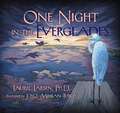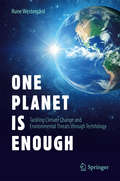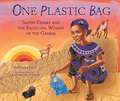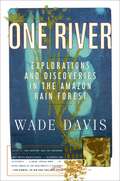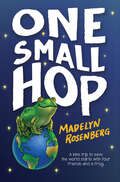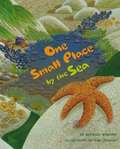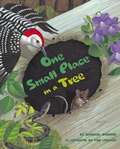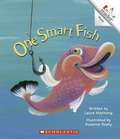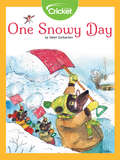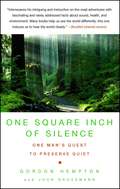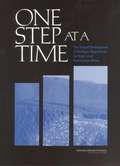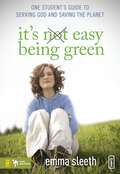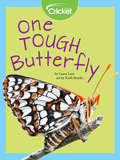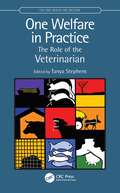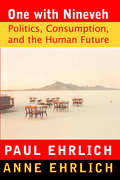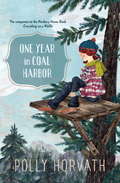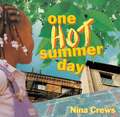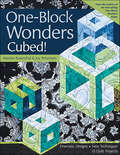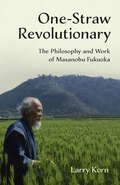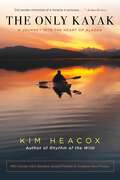- Table View
- List View
One Night in the Everglades
by Laurel LarsenFollow two scientists as they spend a night in the Everglades collecting water samples, photographing wildlife, and sloshing through marshes in an attempt to understand this mysterious ecosystem. Part of a long-term effort to return the Everglades to a natural state after a century of development, the scientists try to figure out what the &“river of grass&” was like prior to human settlement. Along the way, they deal with razor-sharp sawgrass and alligators and turtles and are even surprised by the sudden presence of what is known in the Everglades as a &“frog gigger&”—one who hunts and collects frogs for food!Published in cooperation with the Long Term Ecological Research Network, which is funded by the National Science Foundation.
One Planet Is Enough
by Rune WestergårdThe present book offers a compelling sketch of how technological advances have shaped humankind’s evolution and how they can unlock ways to combat climate change and environmental threats. It also reveals new perspectives on climate change and sustainable development by harnessing technology.Given today’s conditions, only a homeless vegan could achieve a sustainable ecological footprint. In reality, it would be impossible, and even destructive, to attempt to save the planet by discontinuing consumption. It would disrupt evolution and threaten the driving forces of the technology that is our hope for combating climate change and environmental threats in the future. This is the opinion of Rune Westergård, engineer, entrepreneur, and environmental debater, with several decades of experience from the field of environmental and energy technology. He challenges many established truths on consumption and sustainability and demonstrates how and why they are flawed. From his point of view, both continued global growth and increased welfare are entirely possible within the ecological limitations of our planet. Once we learn to put technology to our best advantage, one planet will be enough.
One Plastic Bag: Isatou Ceesay and the Recycling Women of the Gambia
by Elizabeth Zunon Miranda PaulPlastic bags are cheap and easy to use. But what happens when a bag breaks or is no longer needed? In Njau, Gambia, people simply dropped the bags and went on their way. One plastic bag became two. Then ten. Then a hundred.
One River: Science, Adventure And Hallucinogenics In The Amazon Basin
by Wade DavisThe story of two generations of scientific explorers in South America—Richard Evans Schultes and his protégé Wade Davis—an epic tale of adventure and a compelling work of natural history.In 1941, Professor Richard Evan Schultes took a leave from Harvard and disappeared into the Amazon, where he spent the next twelve years mapping uncharted rivers and living among dozens of Indian tribes. In the 1970s, he sent two prize students, Tim Plowman and Wade Davis, to follow in his footsteps and unveil the botanical secrets of coca, the notorious source of cocaine, a sacred plant known to the Inca as the Divine Leaf of Immortality.A stunning account of adventure and discovery, betrayal and destruction, One River is a story of two generations of explorers drawn together by the transcendent knowledge of Indian peoples, the visionary realms of the shaman, and the extraordinary plants that sustain all life in a forest that once stood immense and inviolable.
One Small Candle: The Pilgrims' First Year in America
by Thomas J. FlemingOne Small Candle focuses on the vivid, deeply moving drama of the Pilgrims' first year in the New World. The book begins in London as Pilgrim representatives sign a contract with Christopher Jones, the crusty captain of the old freighter Mayflower. We accompany them on their harrowing voyage across the Atlantic, and march with them over the barren, wintry landscape of Cape Cod in their desperate search for the homesite they eventually find at Plymouth. Howling Indians harass this reconnaissance party, while the weary women and children left aboard the Mayflower struggle against despair. Plymouth at last discovered, we watch "Saints" and "Strangers" forge a common solidarity in their struggle against brutal weather and epidemic disease. But the story is by no means entirely grim and solemn. Young explorers get lost in the woods and climb trees to escape "roaring lions." There is a comic duel for the hand of a headstrong fifteen-year-old. We are present at a bizarre visit to the great Indian chief, Massasoit. With masterly skill, Mr. Fleming gives us life-size portraits of the Pilgrim leaders. The Pilgrims' unique achievements--the Mayflower Compact, their tolerance for other faiths, the strict separation of church and state--are discussed in the context of the first year's anxieties and crises. Special attention is given to the younger men who emerged in this first year as the real leaders of the colony--William Bradford and Miles Standish. And new insights are provided into the deep humanity and tolerance of the Pilgrims' spiritual shepherd, Elder William Brewster. The book ends with the first Thanksgiving. Already in the Pilgrim mind there is a dawning consciousness that they are the forerunners of a great nation. It is implicit in William Bradford's words, "As one small candle may light a thousand, so the light kindled here has shone unto many...."
One Small Hop
by Madelyn RosenbergPerfect for fans of Carl Hiaasen's classic Hoot, this humorous adventure story set in a not-so-distant future celebrates the important differences we can make with small, brave acts.When Ahab and his friends find a bullfrog in their town -- a real, live bullfrog, possibly the last bullfrog in North America -- they have several options:A. Report it to the Environmental Police Force. Too bad everyone knows the agency is a joke.B. Leave it be. They're just a bunch of kids -- what if they hurt it by moving it?C. Find another real, live bullfrog on the black market. Convince their parents to let them bike to Canada. Introduce the two frogs. Save all of frogkind.Ahab convinces the rest of the group that C is their only real option. Because if they don't save this frog, who will? Their quest, which will involve fake ice cream, real frog spawn, and some very close calls, teaches Ahab that hope is always the logical choice and that science is always better with friends.With humor and empathy, acclaimed author Madelyn Rosenberg builds an all-too-imaginable future ravaged by climate change, where one kid can still lean on his friends and dream up a better tomorrow.
One Small Place by the Sea
by Barbara BrennerFor one afternoon, a child visitor observes the cycle of change within a tide pool, a small place at the edge of the sea that is home to many plants and animals.
One Small Place in a Tree
by Barbara BrennerA child visitor observes as one tiny scratch in a tree develops into a home for a variety of woodland animals.
One Smart Fish
by Laura ManivongA child tries to catch a fish using such bait as hot dog meat, cookie dough, and spaghetti.
One Snowy Day
by Valeri GorbachevThe Bear family is enjoying a snowy day! Follow along as Brother Cub and Sister Cub help Daddy Bear shovel the snow before going sledding!
One Square Inch of Silence
by Gordon Hempton John GrossmannIn the visionary tradition of Rachel Carson's Silent Spring, One Square Inch of Silence alerts us to beauty that we take for granted and sounds an urgent environmental alarm. Natural silence is our nation's fastest-disappearing resource, warns Emmy-winning acoustic ecologist Gordon Hempton, who has made it his mission to record and preserve it in all its variety--before these soul-soothing terrestrial soundscapes vanish completely in the ever-rising din of man-made noise. Recalling the great works on nature written by John Muir, John McPhee, and Peter Matthiessen, this beautifully written narrative, co-authored with John Grossmann, is also a quintessentially American story--a road trip across the continent from west to east in a 1964 VW bus. But no one has crossed America like this. Armed with his recording equipment and a decibel-measuring sound-level meter, Hempton bends an inquisitive and loving ear to the varied natural voices of the American landscape--bugling elk, trilling thrushes, and drumming, endangered prairie chickens. He is an equally patient and perceptive listener when talking with people he meets on his journey about the importance of quiet in their lives. By the time he reaches his destination, Washington, D.C., where he meets with federal officials to press his case for natural silence preservation, Hempton has produced a historic and unforgettable sonic record of America. With the incisiveness of Jack Kerouac's observations on the road and the stirring wisdom of Robert Pirsig repairing an aging vehicle and his life, One Square Inch of Silence provides a moving call to action. More than simply a book, it is an actual place, too, located in one of America's last naturally quiet places, in Olympic National Park in Washington State.
One Step at a Time: The Staged Development of Geologic Repositories for High-Level Radioactive Waste
by Committee on Principles Operational Strategies for Staged Repository SystemsCompared to other large engineering projects, geologic repositories for high-level waste present distinctive challenges because: 1) they are first-of-a-kind, complex, and long-term projects that must actively manage hazardous materials for many decades: 2) they are expected to hold these hazardous materials passively safe for many millennia after repository closure; and 3) they are widely perceived to pose serious risks. As is the case for other complex projects, repository programs should proceed in stages. One Step at a Time focuses on a management approach called "adaptive staging" as a promising means to develop geologic repositories for high-level radioactive waste such as the proposed repository at Yucca Mountain, Nevada. Adaptive staging is a learn-as-you-go process that enables project managers to continuously reevaluate and adjust the program in response to new knowledge and stakeholder input. Advice is given on how to implement staging during the construction, operation, closure, and post-closure phases of a repository program.
One Student's Guide to Serving God and Saving the Planet: It's Easy Being Green
by Emma SleethYou've probably heard the story of the garden of Eden-the paradise that God created for humans to live in. There was plenty of room for everyone, there were trees and flowers and plenty of food. When you look out your window today you don't see the paradi
One Tough Butterfly
by Laura LaneQuino butterflies depend on dwarf plantain plants to survive. Climate change and habitat destruction have made it difficult for these plants to grow well, but quino butterflies have been able to adapt quickly and survive.
One Turtle's Last Straw: The Real-Life Rescue That Sparked a Sea Change
by Elisa BoxerThe inspiring true story of how one small turtle and kids all over the country sparked an environmental movement. Based on the viral video that created awareness of the harm caused by plastic straws, this heart-wrenching story is a perfect tool for teaching children about sustainability.Slurp! A boy finishes his drink and tosses it in the trash, straw and all. He moves on without another thought.... In the waters off of Costa Rica, scientists spot an endangered sea turtle and pull him aboard to study him. But he has something stuck in his nose. A barnacle? A stick? No...it's a plastic straw! This heroic story of one turtle's rescue reminds us that even the smallest straw can hurt our ocean life--and that the smallest demand for change can grow into something big!
One Water: Stories
by Rob McCueA taxi driver seeks meaning in the Alaskan backcountry and through stories of the people in his cab in this thoughtful memoir of travel and nature.Rob McCue takes us on a journey from the mountains of Alaska to the streets of its second largest city in a quest to better understand whatever the heck is going on in this world. Along with anecdotes about his encounters with colorful characters and his many wilderness adventures, McCue provides fascinating and insightful descriptions of the geological, biological, and climactic circumstances that have shaped this great land.From Fairbanks to the Yukon River and beyond, McCue brings interior Alaska to life. Meanwhile, he explores his own transformation from a hedonistic young drifter to an adult who accepts his responsibility to his family and community.
One Welfare in Practice: The Role of the Veterinarian (CRC One Health One Welfare)
by Tanya StephensAnimal welfare has long been recognised as central to the role of the veterinary professional, but this is increasingly aligned with the welfare of humans and the broader environment in which we co-exist. This is the first book dedicated to the role of the veterinarian in One Welfare, a concept that recognises the interconnections between animal welfare, human wellbeing, and the environment. The book demonstrates, through a wide range of international case studies, why professional ethics and the use of good evidence is integral to this role. Contributors bring a rich variety of writings, each with their own perception of the role of the veterinarian in improving animal welfare and human wellbeing. One Welfare in Practice: The Role of the Veterinarian emphasises the importance of interdisciplinary collaboration and solutions: it is essential that veterinary practitioners recognise when other professionals or disciplines need to be consulted to benefit both animals and humans. With its multiple, fascinating approaches to One Welfare, this book will inform and inspire the veterinarian to find areas where collaborative action reaps the greatest rewards. This unique book shows how veterinarians can and are contributing to improving animal and human welfare, offering practical advice as to how the profession can further engage in One Welfare in a range of settings.
One Wild Word Away
by Geffrey DavisWhen tensions veer between hope and despair, the ensuing fracture can swing like a scythe and cut a ragged seam between past and present. In One Wild Word Away, Geffrey Davis weaves a deft set of poems about illness, family, loss, and rebirth. The luxurious sonics and crisp descriptions in each line are haunted by grief and buoyed by love as the speaker confronts generational trauma and the loss of a loved one while in the process of raising his own son.
One With Nineveh: Politics, Consumption, and the Human Future
by Paul R. Ehrlich Anne H. EhrlichNamed a Notable Book for 2005 by the American Library Association, One with Nineveh is a fresh synthesis of the major issues of our time, now brought up to date with an afterword for the paperback edition. Through lucid explanations, telling anecdotes, and incisive analysis, the book spotlights the three elephants in our global living room-rising consumption, still-growing world population, and unchecked political and economic inequity-that together are increasingly shaping today's politics and humankind's future. One with Nineveh brilliantly puts today's political and environmental debates in a larger context and offers some bold proposals for improving our future prospect.
One World, One Day
by Barbara KerleyOne World, One Day uses exquisite, moving photographs and Barbara Kerley's poetic text to convey a simple yet profound concept: we are one global family. This is a sophisticated concept book, presented as an elegant picture book with contributions from top international photographers. This beautiful photo book follows the course of one day in our world.
One Year in Coal Harbor
by Polly HorvathReaders rejoice--Primrose Squarp is back! The wise and curious heroine of the Newbery Honor Book Everything on a Waffle is facing another adventure-filled year in Coal Harbor. Even though her parents, once lost at sea, are home, there's a whole slew of problems and mysteries to keep Primrose--and eager fans--busy. There's Uncle Jack and Kate Bowzer, who may (or may not) be in love. There's Ked, a foster child who becomes Primrose's friend. And there's the new development on the outskirts of town that threatens the Coal Harbor Primrose knows and treasures. Prolific and brilliant Horvath has delivered a masterful sequel to a beloved novel, sure to please old fans and gain new ones.
One hot summer day
by Nina CrewsRelates a child's activities in the heat of a summer day punctuated by a thunderstorm.
One-Block Wonders Cubed!: Dramatic Designs, New Techniques, 10 Quilt Projects
by Maxine Rosenthal Joy PelzmannAdd New Dimension to Your Favorite Hexagon Quilts • Your favorite One-Block Wonders authors are back with new graphic techniques using triangles, cubes, and appliqué • Learn how to create optical illusions with your fabrics • Bonus projects include totes, coasters and placemats for using up left-over hexagons • Create interesting shadow effects with clever fabric placement • Try new kinds of borders with uneven edges, creative shapes, and hexagon strips From the best-selling authors of the One-Block Wonders books. New techniques and design strategies using simple geometric shapes give you dramatic quilt imagery that seems to defy logic! Take the ordinary and turn it into something extraordinary with this book.
One-Straw Revolutionary: The Philosophy and Work of Masanobu Fukuoka
by Larry KornOne-Straw Revolutionary represents the first commentary on the work of the late Japanese farmer and philosopher Masanobu Fukuoka (1913 – 2008), widely considered to be natural farming&’s most influential practitioner.Mr. Fukuoka is perhaps most known for his bestselling book The One-Straw Revolution (1978), a manifesto on the importance of no-till agriculture, which was at the time of publication a radical challenge to the global systems that supply the world&’s food, and still inspires readers today. Larry Korn, who apprenticed with Mr. Fukuoka in Japan at the time, translated the manuscript and brought it to the United States, knowing it would change the conversation about food forever. The One-Straw Revolution, edited by Korn and Wendell Berry, was an immediate international success, and established Mr. Fukuoka as a leading voice in the fight against conventional industrial agriculture. In this new book, through his own personal narrative, Larry Korn distills his experience of more than thirty-five years of study with Mr. Fukuoka, living and working on his farm on Shikoku Island, and traveling with Mr. Fukuoka to the United States on two six-week visits. One-Straw Revolutionary is the first book to look deeply at natural farming and intimately discuss the philosophy and work of Mr. Fukuoka. In addition to giving his personal thoughts about natural farming, Korn broadens the discussion by pointing out natural farming&’s kinship with the ways of indigenous cultures and traditional Japanese farming. At the same time, he clearly distinguishes natural farming from other forms of agriculture, including scientific and organic agriculture and permaculture. Korn also clarifies commonly held misconceptions about natural farming in ways Western readers can readily understand. And he explains how natural farming can be used practically in areas other than agriculture, including personal growth and development.The book follows the author on his travels from one back-to-the-land commune to another in the countryside of 1970s Japan, a journey that eventually led him to Mr. Fukuoka&’s natural farm. Korn&’s description of his time there, as well as traveling with Mr. Fukuoka during his visits to the United States, offers a rare, inside look at Mr. Fukuoka&’s life. Readers will delight in this personal insight into one of the world&’s leading agricultural thinkers.&“A profound sharing of the essential philosophy of natural farming translated through the friendship between Larry Korn and Masanobu Fukuoka. . . [It] offers wise insights into authentic practices that honor the community of all life.&”—Katrina Blair, author of The Wild Wisdom of Weeds
Only Kayak: A Journey Into The Heart Of Alaska
by Kim HeacoxWinner of the 2020 National Outdoor Book Award for Outdoor Classic!In this coming-of-middle-age memoir, Kim Heacox, writing in the tradition of Abbey, McPhee, and Thoreau, discovers an Alaska reborn from beneath a massive glacier, where flowers emerge from boulders, moose swim fjords, and bears cross crevasses with Homeric resolve. In such a place Heacox finds that people are reborn too, and their lives begin anew with incredible journeys, epiphanies, and successes. All in an America free of crass commercialism and overdevelopment.Braided through the larger story are tales of gold prospectors and the cabin they built sixty years ago; John Muir and his intrepid terrier, Stickeen; and a dynamic geology professor who teaches earth science "as if every day were a geological epoch."Nearly two million people come to Alaska every summer, some on large cruise ships, some in single kayaks--all in search of the last great wilderness, the Africa of America. It is exactly the America Heacox finds in this story of paradox, love, and loss.
